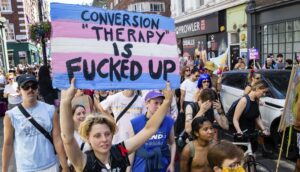When the head of the UK’s largest and longest-running HIV charity, the Terrence Higgins Trust, told this year’s Pride London parade that Britain could soon be the first country in the world to eradicate HIV, the cheer that went up could be heard across Soho. A few of those cheers turned into confusion, however, when Richard Angell revealed the way to stop the epidemic: by “ending the wait in gender-affirming healthcare”. What does a disease that was originally billed as the ”gay plague” — a disease which has killed in excess of 40 million people worldwide — have to do with trans people wanting easier access to hormone treatments or reassignment surgery?
The answer, it seems, lies in a shift in the global HIV response, one that the United Nations hopes will finally “end Aids by 2030”. To push HIV out of the “crisis” stage, in which it has been stuck for decades, and shrink the rate of new infections, health practitioners want a massive roll-out of the preventative medications that are no longer protected by drug company patents or exclusivities. And they want to target that specific sub-population that is disproportionately affected by HIV: transwomen who have sex with men.
In parts of the world, trans prostitutes are up to 80 times more likely than anyone else to be HIV-positive. It is estimated, for example, that in Brazil, as many as a third of travestis — male prostitutes with a female identity — are HIV-positive. Elsewhere, hijra, kathoeys and waria — names used in different cultures for males who adopt female names, clothing, hairstyles and pronouns — are a significant concern for health officials, since they are tricky to monitor and tend to have risky sex with men who often have a female partner at home.
To encourage these at-risk individuals to take part in HIV testing and treatment programmes, global health experts want to offer them a form of integrated care, which could include hormones, reassignment surgery referrals, and other “affirming” services alongside PrEP. As a study in The Journal of the International Aids Society made clear as far back as 2016: in scaling up PrEP for trans women, it is essential to engage trans communities, utilise trans-inclusive research and marketing strategies and identify and/or train healthcare providers to provide gender-affirming healthcare to trans women.”
In India, for instance, a recent white paper detailed a scheme to incentivise hijra and “transgender persons” to take part in HIV screening that involves a comprehensive package of services including gender-affirming care. In Thailand, one programme found that kathoeys were more likely to show up to clinics if they were staffed by transwomen — inspiring trials of similar initiatives in the Philippines, Myanmar and Nepal. It is a strategy that has been adopted in the developed West, too, albeit one that lacks transparency. In 2021, the US Department of Health and Human Services ordered HIV clinics to start offering “gender-affirming care” — a move celebrated in March this year, when the White House made clear that the federal government’s strategy “to end the HIV epidemic” included providing “access to gender affirming care and treatment services to transgender and gender diverse individuals with HIV”.
It is not unusual for health authorities to group services together, or incentivise individuals to make healthy choices. But we have known for at least two decades that transwomen are inordinately at risk of being exposed to HIV. As long ago as 2009, doctors in community clinics in California reported that the availability of hormones and other affirming care would make trans patients more likely to show up to clinics for prevention.
The shift in attention may be down to the fact that, in recent years, with lesbian and gay equality effectively secured in much of the West, LGBT organisations have started to champion transgender causes. But it may also be down to the fact that, in some countries, HIV transmission is beginning to occur at a faster rate among heterosexuals than gay and bisexual men. And this is perhaps in part due to a subsection of heterosexuals, who have transwomen as partners.
Gynandromorphophilia was first coined in 1984 to describe the sexual preferences of ostensibly heterosexual men who are also attracted to males with exaggerated female features, such as big breasts, hips and lips. Gynandromorphophilic males (or Gamps for short) play a role in the transmission of HIV to the general population because their sexual relations with these often high-risk men put their own female partners at risk, which can also result in the virus being passed to unborn babies. We know, too, that heterosexuals tend to be diagnosed late, once their immune system has already been compromised. This also applies to their female partners, who might never suspect that they have been exposed.
In 1995, when Belgian virologist Peter Piot was entrusted with leading the global Aids response at UNAids, it didn’t take him long to realise that stigma relating to sex was the real barrier to ending the epidemic. Shaming “people with diverse sexuality”, Piot said, forces them into the shadows and keeps the virus in circulation.
In an effort to address the estimated 4,500 undiagnosed HIV cases in the UK and halt the virus, the NHS now recommends that certain at-risk groups “may benefit” from taking the now widely and freely available PrEP medication. These at-risk groups include “trans or non-binary person [who] are regularly having condomless sex”. And with this group, “gender-affirming” incentives will increasingly be a part of that medicalising strategy.
While there is an urgent and noble objective here — the eradication of HIV — my worry is that it is taking place without any serious public debate about the consequences. With so much still unknown about the effects of transitioning, gender-affirming therapy is being made more accessible. And at what cost? Only when the HIV epidemic finally ends, will it become clear how subtly it has reshaped the world it’s left behind.
Disclaimer
Some of the posts we share are controversial and we do not necessarily agree with them in the whole extend. Sometimes we agree with the content or part of it but we do not agree with the narration or language. Nevertheless we find them somehow interesting, valuable and/or informative or we share them, because we strongly believe in freedom of speech, free press and journalism. We strongly encourage you to have a critical approach to all the content, do your own research and analysis to build your own opinion.
We would be glad to have your feedback.
Source: UnHerd Read the original article here: https://unherd.com/



